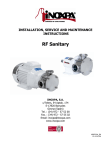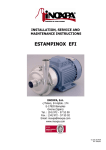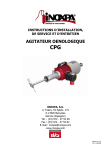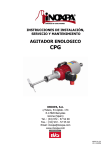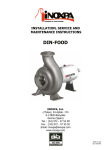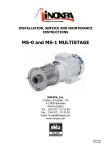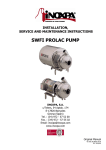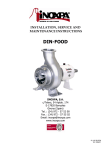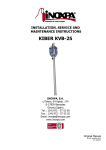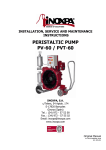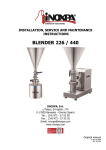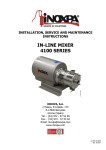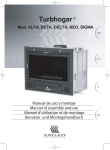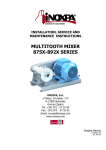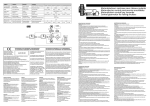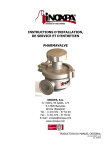Download Inoxpa Prolac HP
Transcript
INSTALLATION, SERVICE AND MAINTENANCE INSTRUCTIONS PROLAC HP (HIGH PRESSURE) INOXPA, S.A. c/Telers, 54 Aptdo. 174 E-17820 Banyoles Girona (Spain) Tel.: (34) 972 - 57 52 00 Fax.: (34) 972 - 57 55 02 Email: [email protected] www.inoxpa.com MIPROHP-03_EN ED. 12.02/08 EC DECLARATION OF CONFORMITY (according to Directive 98/37/CE, annex II, part A) INOXPA, S.A. C/ Telers, 54 17820 Banyoles (Girona) - SPAIN Manufacturer: Hereby declares, that the product: CENTRIFUGAL PUMP PROLAC HP Name Type 2008 2008 Year of manufacture conforms to the specifications of the Council Directive: Machine Directive 98/37/CE, and complies with the essential requirements of the Directive and Harmonised Standards: UNE-EN ISO 12100-1/2:2003 UNE-EN 1050:1996 UNE-EN 809/AC:2001 UNE-EN 294/AC:1993 UNE-EN 953:1997 UNE-EN 563/A1/AC:2000 Low Voltage Directive 2006/95/EC (repeals 73/23/CEE Directive), and conforms to UNE-EN 60204-1:1997 and UNE-EN 60034-1/A11:2002 EMC Directive 2004/108/EC (repeals 89/336/CEE Directive), and conforms to UNEEN 60034-1/A11:2002 In compliance with the Regulations (CE) nº 1935/2004, on materials and objects intended to come into contact with foodstuffs (repealing 89/109/EEC), in accordance with which the materials in contact with the product do not transfer its constituents to the foodstuffs in quantities large enough to put human health at risk. Declaration of Incorporation (Directive 98/37/CE, annex II, part B): The aforementioned equipment shall not be commissioned until the machine in which they will be incorporated has been declared as being in conformity with the Machine Directive. Banyoles, february January 2008 2008 1. Safety 1.1. INSTRUCTION MANUAL This instruction manual contains information on the reception, installation, operation, fitting, disassembly and maintenance for the PROLAC HP pump. The information given herein is based on the most up-to-date data available. INOXPA reserves the right to modify this instructions manual without prior notice. 1.2. START-UP INSTRUTIONS This instruction manual contains vital and useful information for properly operating the pump and for keeping it in good running condition. Not only should the safety instructions set forth in this chapter be carefully read before putting the pump into operation, but those concerned must also familiarise themselves with the operating features of the pump and strictly adhere to the instructions given herein. It is extremely important that these instructions be kept in a set place near the installation 1.3. SAFETY 1.3.1. Warning signs Danger for people in general. Danger of injury caused by rotating parts of the equipment. Danger! Electricity. Danger! Caustic or corrosive agents. Danger! Suspended loads. Danger to the proper operating of the machine. Obligation to ensure safety at work. Use of safety goggles obligatory. 1.4. GENERAL SAFETY INSTRUCTIONS Please read the instruction manual thoroughly before installing and commissioning the pump. Should you have any doubts or queries, contact INOXPA. 1.4.1. During the installation You must always bear in mind the Technical Specifications set forth in Chapter 8. Do not put the pump into operation before connecting it to the pipes. Do not put the pump into operation if the cover of the pump has not been fitted and the impeller fixed in the pump. Check that the motor specifications are correct, especially if there is a special risk of explosion due to the work conditions. During the installation procedure, all the electrical work must be carried out by duly authorised personnel. 1.4.2. During operation You must always bear in mind the Technical Specifications set forth in Chapter 8. The limit values that have been set must NEVER be exceeded. NEVER touch the pump or pipes whenever the pump is being used to decant hot liquids or during the cleaning procedure. ED. 12.02/08 1.Safety 3 The pump has moving parts. Do not put your fingers into the pump when it is operating. NEVER work with the suction and the delivery valves shut off. NEVER directly sprinkle the electric motor with water. Standard motor protection is IP-55: dust and water sprinkling protection. 1.4.3. During maintenance You must always bear in mind the Technical Specifications set forth in Chapter 8. NEVER strip the pump down until the pipes have been drained. Remember that there will always be some liquid left in the pump casing (if it has not been fitted with a drain). Always remember that the liquid that has been pumped may be dangerous or subject to high temperatures. For situations of this type, please consult the prevailing regulations in the country in question. Do not leave loose parts on the floor. ALWAYS turn the power supply to the pump off before embarking on maintenance work. Take out the fuses and disconnect the wires from the motor terminals. All electrical work must be carried out by duly authorised personnel. 1.4.4. In accordance with the instructions Any failure to comply with the instructions could lead to a hazard for the operators, the atmospheric conditions of the room, and the machine, and it could lead to a loss to any right to make a claim for damages. Such non-compliance could bring with it the following risks: • Important operating failures of the machine / plant. • Failure to comply with specific maintenance and repair procedures. • Potential electrical, mechanical and chemical hazards. • Atmospheric conditions in the room could be hazardous due to the release of chemical substances. 1.4.5. Warranty We wish to point out that any warranty issued will be null and void and that we are entitled to an indemnity for any civil liability claim for products which might be filed by third parties if: • Operation and maintenance work has not been done following the corresponding instructions; the repairs have not been made by our personnel or have been made without our written authorization; • Modifications are made to our material without prior written authorization; • The parts or lubricants used are not original INOXPA parts/lubricants; • The material has been improperly used due to error or negligence or have not been used according to the indications and the intended purpose. • The parts of the pump have been damaged as a result of having been exposed to strong pressure as there was no safety valve. The General Delivery Terms which you have already received are also applicable. No modification can be made to the machine without the prior consent of the manufacturer. For your safety, use spare parts and original accessories. The use of other parts exempts the manufacturer from any and all responsibility. Any change in operating conditions can only be done with the prior written consent of INOXPA. In the event of doubt or should you require a fuller explanation on particular data (adjustment, assembly, disassembly...), please do not hesitate to contact us 4 1.Safety ED. 12.02/08 2. Index 1. Safety 1.1. Instruction manual .......................................................................................................... 3 1.2. Start-up instrutions.......................................................................................................... 3 1.3. Safety............................................................................................................................. 3 1.4. General safety instructions ............................................................................................... 3 2. Index 3. General Information 3.1. Description...................................................................................................................... 6 3.2. Operating principle .......................................................................................................... 6 3.3. Application ...................................................................................................................... 6 4. Installation 4.1. Pump reception ............................................................................................................... 8 4.2. Transport and storage ..................................................................................................... 8 4.3. Location.......................................................................................................................... 9 4.4. Pipes .............................................................................................................................. 9 4.5. Electrical intallation.......................................................................................................... 9 5. Start-Up 5.1. Start-up .........................................................................................................................10 6. Operating problems 7. Maintenance 7.1. General maintenance......................................................................................................12 7.2. Torque...........................................................................................................................12 7.3. Storage..........................................................................................................................12 7.4. Cleaning ........................................................................................................................12 7.5. Pump disassembly/assembly ...........................................................................................14 8. Technical Specifications 8.1. Technical specification ....................................................................................................18 8.2. Weights .........................................................................................................................18 8.3. PROLAC HP dimensions ..................................................................................................19 8.4. PROLAC HP pump...........................................................................................................20 8.5. PROLAC HP pump section ...............................................................................................21 8.6. Parts list PROLAC HP pump .............................................................................................22 ED. 12.02/08 2.Index 5 3. General Information 3.1. DESCRIPTION INOXPA PROLAC HP-series centrifugal pumps have been especially designed to work under pressure of up to 40 bar. PROLAC HP centrifugal pump is a robust close-coupled pump with a shrouded motor, axial suction and radial delivery, and hygienic-type connections. The impeller is of an open or half-open design according to the model, and manufactured in a single piece. The mechanical seal is balanced, specially made to work at high pressure, and it is completely hygienic. The working surfaces are silicon carbide and graphite and gaskets material is EPDM in the standard version. The motor complies with IEC standards. IP-55 protection. Class-F insulation. Three-phase power 220-240 / 380-420 V or 380420 / 660 V at 50 Hz, depending on power supply. It is a motor with reinforced bearings in order to counteract the axial impulse caused by the impeller. On demand, it is possible to provide motors intended for work in explosive environments. Depending on the environmental conditions, the motors can be flameproof (EExd) or increased safety (EExe). The parts in contact with the product are made of AISI 316L stainless steel and an internal finish is Ra 0.8. PROLAC HP pumps are hygienic pumps that comply with the highest hygiene requirements for use in the food and pharmaceutics industries. 3.2. OPERATING PRINCIPLE The pump impeller, housed in the pump housing, turns along with the pump shaft. It is fitted with a certain number of blades in accordance with the model of pump chosen. Given this design, the impeller blades transmit both pressure and kinetic energy to the fluid in question. The pump cannot be reversed by simply changing of the rotation direction. The rotation direction, to be seen from the rear of the motor, should be clockwise. 3.3. APPLICATION As a general rule, standard version PROLAC HP pumps are mainly used in the filtering and reverse osmosis processes. For each pump type the hydraulic specifications are provided depending on impeller diameters and speed rates. The performance curves also show the absorbed power and required NPSH. 6 3.General Information ED. 12.02/08 3.3.1. Range of application Each pump has a limited field of application. The pump in question was selected for certain pumping conditions at the time the order was made. INOXPA is not liable for any damages that might arise if the information furnished by the purchaser is incomplete (nature of the liquid, RPM…). ED. 12.02/08 3.General Information 7 4. Installation 4.1. PUMP RECEPTION INOXPA is not responsible for any deterioration of the material as a result of its transportation or unpacking. Visually check that the packing has not suffered any damage. The pump will be accompanied by the following documentation: • Dispatch notes. • Pump Instruction and Service Manual. • Motor Instruction and Service Manual (*). • (*) If the pump has been supplied with a motor from INOXPA. Unpack the pump and check the following: • The pump suction and delivery connections, removing the remains of any packing material. • Check that the pump and the motor have not suffered any damage. • Should the pump not be in proper condition and/or does not have all the parts, the carrier must draw up a report as soon as possible with regard to the same. 4.1.1. Pump identification and marking Serial number Pump plate 4.2. TRANSPORT AND STORAGE PROLAC HP pumps are quite often too heavy to be put into their storage space manually. Lift the pump as shown below: • Always remove the shroud, if installed, before lifting the pump. 8 4.Installation ED. 12.02/08 4.3. LOCATION • Position the pump as near as possible to the suction tank, and whenever possible below the level of the liquid. • Place the pump in such a way that there is enough space around it to provide access both to the same and to the motor. (See Chapter 8. Technical Specifications to consult dimensions and weights). • Place the pump on a level and flat surface. • The basement must be rigid, horizontal and against any vibration. Install the pump in such a way that it can be properly ventilated. If the pump is to be installed outside, it must be done so under cover. Its positioning must enable easy access for any inspection and maintenance operations that may need to be carried out. 4.4. PIPES • In general, suction and delivery pipes should be fitted in straight stretches, with the minimum amount of elbows and accessories, in order reduce, as far as possible, any load loss that might be produced by friction. • Make sure that the pump mouths are well aligned with respect to the piping, and that they are similar in diameter to that of the pipe connections. • Position the pump are near as possible to the suction tank, and whenever possible below the level of the liquid, or even lower with respect to the tank in order for the static suction head be at its maximum. • Place supports for the pipes as near as possible to the suction and delivery nozzles of the pump. 4.4.1. Shut-off valves The pump can be isolated for the purpose of carrying out maintenance work. To this end, shut-off valves should be fitted at the pump suction and delivery connections. These valves must ALWAYS be open whenever the pump is operating. 4.5. ELECTRICAL INTALLATION Leave the connecting of the electrical motors to qualified personnel. Take the necessary measures to prevent any breakdowns in the connections and wires. The electrical equipment, the terminals and the components of the control systems may still carry an electric charge even when disconnected. Contact with them may put the safety of operators at risk, or cause irreparable damage to the material. Before manoeuvring the pump, make sure that the electric box is switched off. • • Connect the motor in accordance with the instructions supplied by the manufacturer. Check the direction of the rotation (see the signaling label on the pump). Put the pump motor into operation momentarily. Make sure, by looking at the pump from the rear, that the motor ventilator is rotating in a clockwise direction. Check ALWAYS the direction of the motor rotation with liquid inside the pump. For the models with sealing chamber, make sure always that it is filled with liquid before checking the rotating direction. ED. 12.02/08 4.Installation 9 5. Start-Up Before putting the pump into operation read thoroughly the instructions on installation given in Chapter 4. Installation. 5.1. START-UP Read Chapter 8. Technical Specifications thoroughly. INOXPA will not assume responsibility for any improper or incorrect use of the equipment. Do not touch the pump or the piping while it is pumping products at a high temperature. 5.1.1. Checks to be carried out before putting the pump into operation • Completely open the pipe suction and delivery shut-off valves. • If the liquid fails to flow toward the pump, fill it with the liquid to be pumped. The pump must NEVER be run dry. • Check that the rotation direction of the motor is correct. 5.1.2. Checks to be carried out on putting the pump into operation • Check to make sure that the pump is not making any strange noises. • Check to see if the absolute inlet pressure is sufficient, in order to avoid cavitations in the pump. Consult the curve for the minimum required pressure above the steam pressure (NPSHr). • Monitor the delivery pressure. • Check that there are no leaks in the sealed areas. A shut-off valve should not be used in the suction pipe to regulate the flow rate. It must be completely open during operation. Monitor motor consumption in order to avoid a circuit overload. Reduce the flow and the power consumed by the motor: • Regulating the flow to the pump delivery. • Decreasing motor speed. 10 5.Start-Up ED. 12.02/08 6. Operating problems The table given below provides solutions to problems that might arise during pump operation. With respect to the same, it is assumed that the pump has been properly installed and has been correctly selected for the application in question. Should there be a need for technical service please contact INOXPA. Incidentes de funcionamiento Causas probables Overloading of motor. Insufficient flow rate or pressure in pump. No pressure on the discharge side. Irregular discharge flow rate / pressure. Noise and vibrations. The pump gets clogged. Overheating of the pump. Abnormal wear. Leak in mechanical seal. 8, 9, 13, 14, 20, 21, 22, 23, 24. 1, 2, 4, 5, 7, 9, 10, 17, 19. 2, 3, 6, 18. 1, 2, 4, 5, 6, 9. 2, 4, 5, 6, 7, 8, 9, 10, 13, 14,15, 20, 21, 22, 23, 24. 9, 10, 13, 14, 15, 20, 21, 22, 24. 8, 9, 10, 13, 14, 15, 20, 21, 22, 23, 24. 4, 5, 10, 14, 15, 20, 24. 11, 12, 16. Causas probables Soluciones 1 2 Wrong rotation direction. Insufficient NPSH. Invert the direction of rotation. 3 4 5 6 7 Non-purged pump. Cavitation. The pump is sucking air. Obstructed suction piping. Delivery pressure is too high. 8 Flow is too high. 9 10 11 12 13 The viscosity of the liquid is too high. The temperature of the liquid is too high. Mechanical seal either damaged or worn. Unsuitable O-ring for the liquid in question. The impeller is rubbing. 14 15 16 17 18 19 Pressure in the pipes. There are foreign bodies in the liquid. The tension of the mechanical seal spring is too low. The pump speed is too low. The suction shutoff valve is closed. Delivery pressure is too low. 20 21 22 23 24 Worn bearing. Not enough lubricating oil. Unsuitable lubricating oil. Non aligned coupling. Pump and/or motor not fixed to the base-plate. Increase available NPSH: - Raise the suction deposit. - Lower the pump. - Reduce the vapour pressure. - Increase the diameter of the suction pipe. - Shorten and simplify the suction pipe. Purge or fill. Increase suction pressure (also see 2). Check the suction pipe and all its connections. Check suction pipe and the filters, if any. If necessary, reduce head losses, for ex., by increasing the pipe diameter. Reduce the flow rate: - Reduce the flow rate using a diaphragm. - Partially close the discharge valve. - Trim the impeller. - Decrease the speed. Reduce the viscosity, for ex., by heating the liquid. Reduce the temperature by cooling the liquid. Replace the seal. Insert the proper O-rings; check with the supplier. - Decrease the temperature. - Decrease the suction pressure. - Adjust the clearance between the impeller and the housing. Connect the pipelines to the pump free of tension. Place a filter in the suction. Adjust as indicated in the manual. Increase the speed. Check and open. Increase the pressure: - Increase the diameter or the impeller. - Increase the speed of the pump. Replace the bearings, check the pump. Fill up with oil. Use an appropriate oil. Align the coupling. Affix the pump and/or the motor to the base-plate, check to see if the pipes are connected without pressure and align the coupling. If the problems persist stop using the pump immediately. Contact the pump manufacturer or his representative. ED. 12.02/08 6.Operating problems 11 7. Maintenance 7.1. GENERAL MAINTENANCE This pump, as with any other machine, needs to be maintained. The instructions contained in this manual deal with the identification and replacement of the spare parts. These instructions have been drawn up by maintenance staff and are destined for those people who are responsible for supplying spare parts. Read thoroughly Chapter 8. Technical specifications. All the parts or materials that are changed must be duly eliminated/recycled in accordance with the prevailing directives in each area. ALWAYS disconnect the pump before starting out on any maintenance work. 7.1.1. Check the mechanical seal Periodically check that there are no leaks in the shaft area. Should there be any leaks in the mechanical seal area, replace the same pursuant to the instructions given in the section Disassembly and Assembly of the pump. 7.2. DRY THREAD TORQUE Material Dry thread torque [N.m.] M5 M6 M8 M10 M12 M14 M16 M18 M20 8.8 6 10 25 49 86 135 210 290 410 A2 5 9 21 42 74 112 160 210 300 7.3. STORAGE Before being stored the pump must be completely emptied of liquids. Avoid, as far as possible, the exposure of the parts to excessively damp atmospheres. 7.4. CLEANING The use of aggressive cleaning products such as caustic soda and nitric acid may cause skin burns. Use rubber gloves during the cleaning process. Always use protective goggles. 12 7.Maintenance ED. 12.02/08 7.4.1. Automatic CIP (Clean-in-place) If the pump is installed in a system provided with a CIP process, there will be no need for disassembly. If it is not fitted with an automatic cleaning process, disassemble the pump pursuant to the instructions given in the section Disassembly and Assembly of the pump. Cleaning solutions for CIP processes. Only use clear water (chloride free) to mix with the cleaning agents: a) Alkaline solution: 1% in weight of caustic soda (NaOH) to 70ºC (150ºF) 1 Kg NaOH + 100 l. water = cleaning solution or 2.2 l. NaOH al 33% + 100 l. of water = cleaning solution b) Acid solution: 0.5% in weight of nitric acid (HNO3) to 70ºC (150ºF) 0.7 liters HNO3 to 53% + 100 l. water = cleaning solution Monitor the concentration of cleaning solutions, it could cause the deterioration of the pump sealing gaskets. In order to remove any remains of cleaning products, ALWAYS rinse the element in question with clean water after completing the cleaning process. 7.4.2. Automatic SIP (sterilization-in-place) The process of sterilization with steam is applied to all the equipment including the pump. Do NOT start the equipment during the process of sterilization with steam. The parts/materials suffer no damage if the indications specified in this manual are observed. No cold liquid can enter the equipment till the temperature of the equipment is lower than 60°C (140°F). A flow by-pass is recommended to be used in order to assure the flow of sterile product after the pump. Maximum conditions during the SIP process with steam or overheated water a) b) c) d) ED. 12.02/08 Max. temperature: Max. time: Cooling: Materials: 140°C / 284°F 30 min Sterile air or inert gas EPDM / PTFE (recommended) FPM / NBR (not recommended) 7.Maintenance 13 7.5. PUMP DISASSEMBLY/ASSEMBLY 7.5.1. Pump casing and impeller Disassembly Remove the hexagonal screws (52) and washers (53A) that fix the housing (01) to the lantern (04). Remove the blind nut (45) and O-ring (80D), then take out the impeller (02). Assembly Slide the impeller (02) over the shaft (05), place the O-ring (80D) in the slot of the blind nut (45) and tighten the nut (45). Assemble the housing (01) and fix it to the lantern (04) with hexagonal screws (52) and washers (53A). 7.5.2. Simple mechanical seal Disassembly Remove the rotary part of the mechanical seal (08). Remove the protector (47A) by removing the screws (50A). Remove the screws (52C) and washers (53E) that fix the cover (03) with the lantern (04). Remove the pump cover (03), the fixed part of the mechanical seal (08) will remain housed inside the cover. Remove the fixed part of the mechanical seal (08). 14 7.Maintenance ED. 12.02/08 ATTENTION! When assembling the new seal, be careful and mount the parts and the O-rings with soapy water in order to allow an easy glide of the parts, either the stationary part and the rotary part on the shaft. Assembly Check the position of the shaft (05) in relation to the pump cover (03). See section 7.5.3. Adjusting the pump shaft. Attach the pump cover (03) to the lantern (04) and fasten the screws (52C) and washers (53E). Place the fixed part of the mechanical seal in the cover housing (03), mind the pivot. Check that the assembly dimension used is as described below: Slide the rotating part of the mechanical seal (08) over the shaft (05) till the end. Finally, fix the protectors (47A) with the screws (50A). ED. 12.02/08 7.Maintenance 15 7.5.3. Adjusting the pump shaft Slide the impeller (02) over the shaft (05) until reaching the rotary part of the mechanical seal (08). Place a rod in the hole of the shaft (05) to prevent rotation. Attach the O-ring (80D) in the slot at the base of the blind nut (45). Tighten the blind nut (45). Check that the clearance between the impeller (02) and the cover (03) is as indicated below. Pump type A (mm) S-26 1 S-35 0,7 S-37 0,7 S-38 0,5 If not, adjust the dimension until it is as indicated below. • Loosen the Allen screws (51) and slide the shaft (05) until the dimension has been adjusted. Finally, tighten the screws. 16 7.Maintenance ED. 12.02/08 7.5.4. Lantern and motor Disassembly Remove the shroud. Remove the hexagonal screws (52A), nuts (54), and washers (53) and (53B), take out the lantern (04) and the front part of the shroud. Loosen the Allen screws (51) and take out the shaft (05) and splash ring (82). Remove the screws (52B), nuts (54A), and washers (53C) and (53D). This will make it possible to remove the motor (93) from the base plate (38). Assembly Place the motor (93) onto the base plate (38) and place screws (52B), nuts (54A), and washers (53C) and (53D). Slide the shaft (05) over the shaft of the motor (93) till the end, and fasten it with Allen screws (51). Attach the splash ring (82) to the shaft (05). Place the front part of the shroud and the lantern (04) in their assembly position and fix them to the motor (93) with hexagonal screws (52A), nuts (54), and washers (53) and (53B). Assemble the shroud. ED. 12.02/08 7.Maintenance 17 8. Technical Specifications 8.1. TECHNICAL SPECIFICATION 50Hz -1 Maximum flow rate (1450 min ) .............................................. Maximum differential height .................................................... Maximum operating pressure .................................................. Operating temperature ........................................................... Maximum speed...................................................................... Suction / discharge connections ............................................. 60Hz 3 160m /h (704 US g.p.m.) 60m (197 ft) 40 bar (580 PSI) -10 ºC to +120 ºC (EPDM) 14 ºF to 248 ºF (EPDM) Temporal temperature up to 140 ºC / 284 ºF (EPDM) 3000 r.p.m. DIN 11851 (Standard) 190 m3/h (837 US g.p.m.) 80m (262,5 ft) 40 bar (580 PSI) -10 ºC to +120 ºC (EPDM) 14 ºF to 248 ºF (EPDM) Temporal temperature up to 140 ºC / 284 ºF (EPDM) 3600 r.p.m. DIN 11851 (Standard) Whenever the noise level in the area of operation exceeds 85 dB(A) use special protection. Materials Parts in contact with the product ............................................ Other parts in stainless steel ............................................... Gaskets in contact with the product ............................ Other optional gasket materials ........................................ Surface finish .................................................................. AISI 316L AISI 304 EPDM (Standard) Consult your supplier Standard finish Mechanical seal Seal type ............................................................................... Stationary parts material ......................................................... Rotary parts material .............................................................. Seals material ........................................................................ Internal balanced single seal Graphite SiC EPDM (Standard) 8.2. WEIGHTS Weight Weight [kg] [lbs] 100 60 132 112 65 143 S-35 132 98 216 S-37 160 173 381 160 196 432 180 216 476 200 347 765 Pump Type S-26 S-38 18 MOTOR 8.Technical Specifications ED. 12.02/08 8.3. PROLAC HP DIMENSIONS PUMP TYPE S-26 D E DNa DNi A B C D E 65 50 76 600 79 239 170 F 290 297 G H I J K L M 140 185 355 330 265 295 13 S-35 F 65 50 84 740 101 284 192 358 170 220 410 380 310 350 13 S-37 G 80 65 88 905 100 259 250 410 260 360 525 465 415 470 18 260 360 465 415 470 18 305 400 650 545 600 23 G S-38 H J ED. 12.02/08 100 80 115 930 1105 107 365 250 340 8.Technical Specifications 432 457 459 505 525 690 19 8.4. PROLAC HP PUMP 20 8.Technical Specifications ED. 12.02/08 8.5. PROLAC HP PUMP SECTION ED. 12.02/08 8.Technical Specifications 21 8.6. PARTS LIST PROLAC HP PUMP Position Description 01 Material S-26 S-35 S-37 S-38 Pump housing 1 1 1 1 AISI 316L 02 Impeller 1 1 1 1 AISI 316L 03 Pump cover 1 1 1 1 CF-3M 04 Lantern 1 1 1 1 CF-8 05 Shaft 1 1 1 1 AISI 316L 08 Mechanical seal 1 1 1 1 SiC/C/EPDM 14 Shroud 1 1 1 1 AISI 304 38 Baseplate 1 1 1 1 AISI 304 45 Blind nut 1 1 1 1 AISI 316L 47A Protection 2 2 2 2 PET-PLUS 50A Screw 4 8 8 8 A2 51 Allen screw 2 2 2 2 A2 52 Hexagonal screw 6 8 8 12 A2 52A Hexagonal screw 4 4 4 4 A2 52B Hexagonal screw 4 4 4 4 A2 52C Hexagonal screw 2 2 2 2 A2 Plane washer 4 8 4 4 A2 53A Grower washer 6 8 12 16 A2 53B Grower washer 4 8 - - A2 53 22 Quantity 53C Grower washer 4 - 4 4 A2 53D Plane washer 4 - 4 4 A2 53E Plane washer 2 2 2 2 A2 54 Hexagonal nut 4 8 4 4 A2 54A Hexagonal nut 4 - 4 4 A2 80A O-ring 1 1 1 1 EPDM 80D O-ring 1 1 1 1 EPDM 82 Splash ring 1 1 1 1 EPDM 93 Motor 1 1 1 1 - 8.Technical Specifications ED. 12.02/08 NOTES INOXPA, S.A. C/ Telers, 54 - PO Box: 174 Tel: (+34) 972 575 200 Email: [email protected] 17820 BANYOLES (Girona - Spain) Fax: (+34) 972 575 502 www.inoxpa.com MADRID – INOXFLUID, S.L Tel: 918 716 084 e-mail: [email protected] BILBAO – STA, S.L. Tel: 944 572 058 e-mail: [email protected] VALENCIA – INOXDIN, S.L. Tel: 963 170 101 e-mail: [email protected] VALLADOLID – ALTAFLUID, S.L. Tel: 983 403 197 e-mail: [email protected] JEREZ – CORFLUID, S.L. Tel: 956 140 193 e-mail: [email protected] ZARAGOZA – FLUAL, S.L. Tel: 976 591 942 e-mail: [email protected] LA RIOJA – STA, S.L. Tel: 941 228 622 e-mail: [email protected] SEVILLA – CORFLUID, S.L. Tel: 954 296 852 e-mail: [email protected] CÓRDOBA – CORFLUID, S.L. Tel: 957 169 145 e-mail: [email protected] LA MANCHA – INOXFLUID, S.L. Tel: 926 514 190 e-mail: [email protected] ASTURIAS – STA, S.L. Tel: 985 267 553 e-mail: [email protected] INOXPA FRANCE, S.A. - AGENCE NORD 2, Avenue Saint Pierre 59118 WAMBRECHIES (France) Tel: 33(0)320 631000 Fax: 33(0)320 631001 e-mail: [email protected] AGENCE LYON Z.A.C. D’EPINAY 69 Allée des Caillotières GLEIZE 69400 (France) Tel: 33(0)474 627100 Fax: 33(0)474 627101 e-mail: [email protected] AGENCE SUD EST Route d’Olonzac 11200 HOMPS (France) Tel: 33(0)468 278680 Fax: 33(0)468 278681 e-mail: [email protected] AGENCE OUEST ZA des Roitelières 44330 LE PALLET (France) Tel: 33(0)228 010172 Fax: 33(0)228 010173 e-mail: [email protected] INOXPA SOLUTIONS FRANCE Rue Henri Becquerel F - 60230 CHAMBLY (France) Tel: 33(0)130289100 Fax: 33(0)130289101 e-mail: [email protected] INOXPA ITALIA S.R.L. Via Olivetti, s.n.c., Z.I. 26010 VAIANO CREMASCO - Cr - (Italia) Tel: 39(0)373 791076 Fax: 39(0)373 791113 e-mail: [email protected] INOXPA SWEDEN Laxfiskevägen 12 SE-43338 PARTILLE (Sweden) Tel: 46 (0) 31 336 05 60 Fax: 46 (0) 31 336 05 61 e-mail: [email protected] INOXPA SKANDINAVIEN A/S H∅egh Guldbergsgade 27 HORSENS DK-8700 (Denmark) Tel: (45) 76 28 69 00 Fax: (45) 76 28 69 09 e-mail: [email protected] INOXPA SOUTH AFRICA (PTY) LTD PO Box 782 7435 MILNERTON – CAPE TOWN (Republic of South Africa) Tel: 27(0)11 796 5170 Fax: 27(0)11 796 5172 e-mail: [email protected] S.T.A. PORTUGUESA LDA. Zona Industrial - Lugar do Guardal ALGERIZ. 3730-266 VALE DE CAMBRA (Portugal) Tel: 351 256 472722 Fax: 351 256 425697 e-mail: [email protected] INOXPA POLAND sp z o.o. Ul. Arkonska, 54 80-392 Gdansk (Poland) Tel. 48 58 511 00 05 Fax 48 58 556 72 51 e-mail: [email protected] INOXPA USA, Inc 3715 Santa Rosa Avenue Suite A4 Santa Rosa, CA95407 (California) Tel: 1 707 585 3900 Fax: 1 707 585 3908 e-mail: [email protected] INOXPA DEUTSCHLAND GMBH Kohlhammerstrasse, 6 D - 70771 LEINFELDEN DEUTSCHLAND Tel: 49 711 758 59 73 Fax: 49 71175859750 e-mail: [email protected] INOXPA REALM LTD Gladstone Road CROYDON, SURREY CR0 28BQ Tel: 44 2086895521 Fax: 44 2086890245 e-mail: [email protected] INOXRUS Ulitsa Verjnaya 4, Parnas 194292 Saint Petersburg Russia Tel: 7 812 622 16 26 Fax: 7 812 622 19 26 e-mail: [email protected] BARCELONA – FLUAL, S.L. Tel: 937 297 280 e-mail: [email protected] Gsm: (+34) 667 16 85 20 INOXPA products are available from our branch offices and through a network of independent distributors covering more than 50 countries around the World. For more information, visit our Web site: www.inoxpa.com This information is given for guidance only. We reserve the right to change any materials or characteristics without prior notice.
























